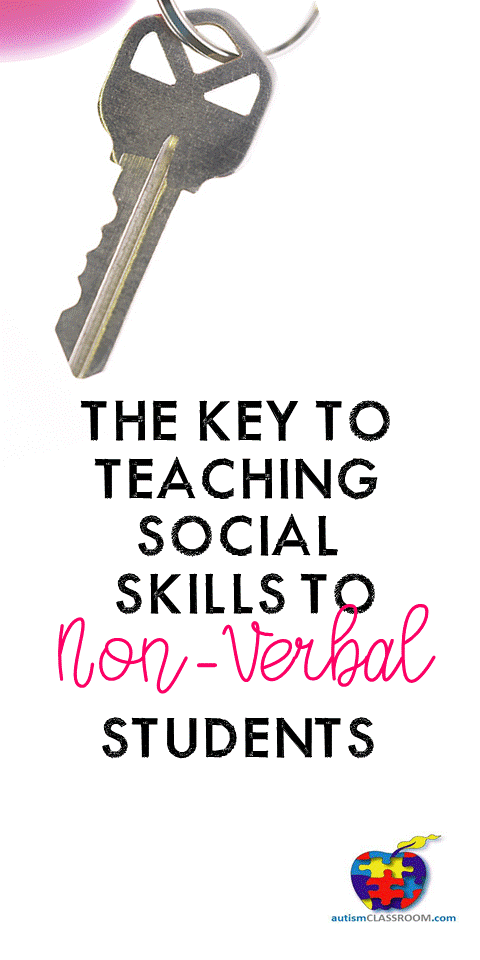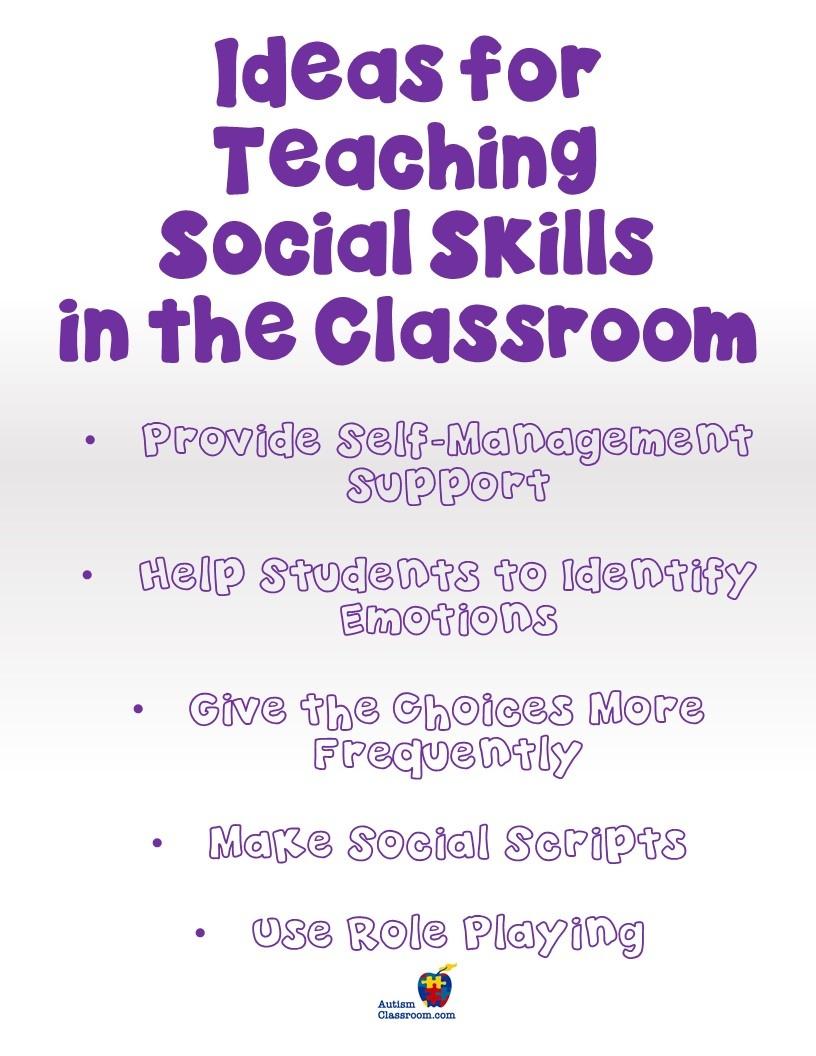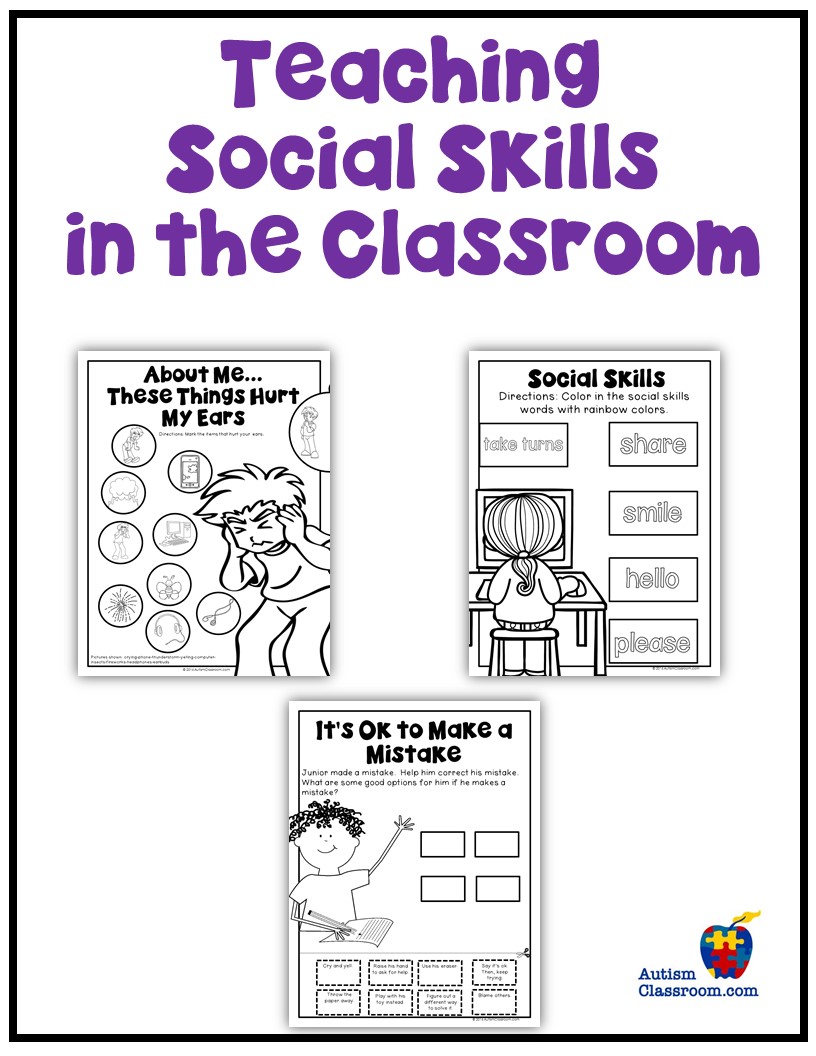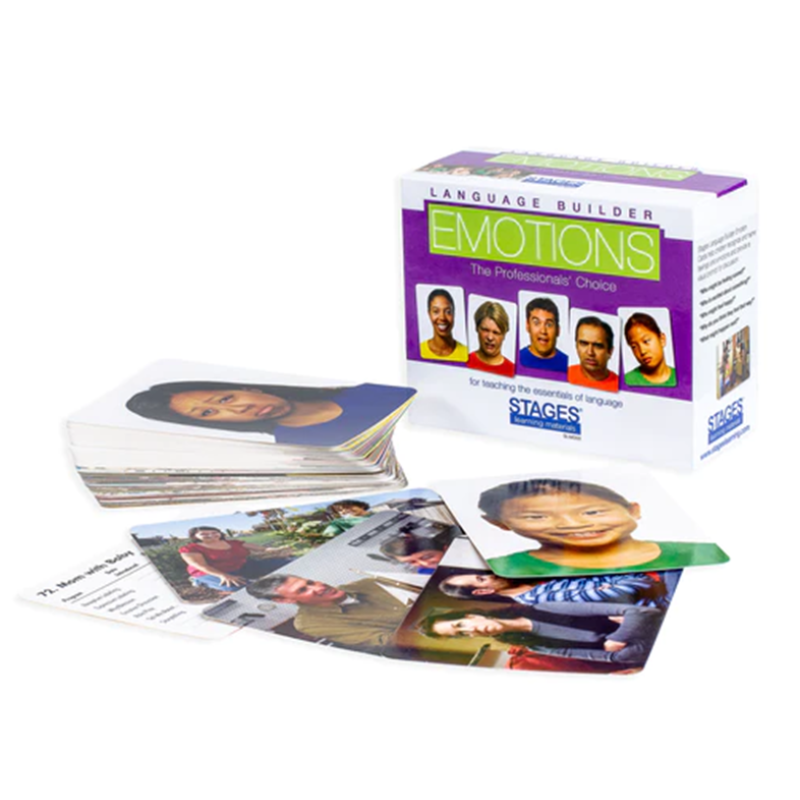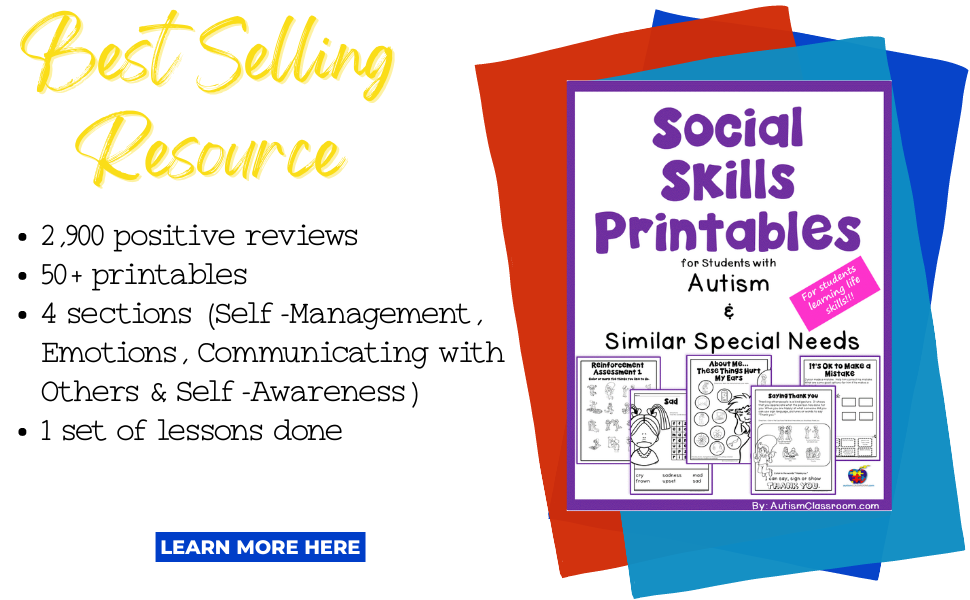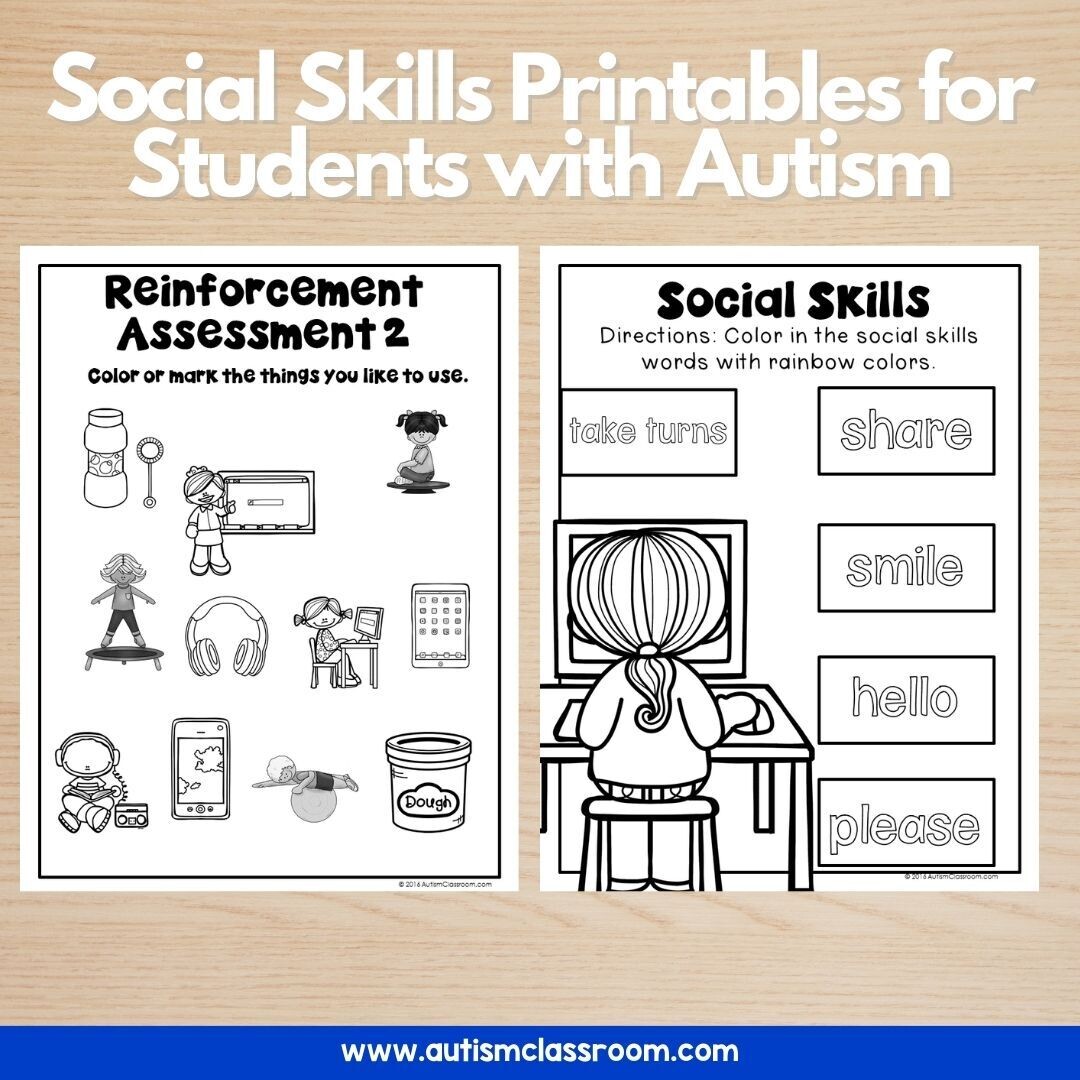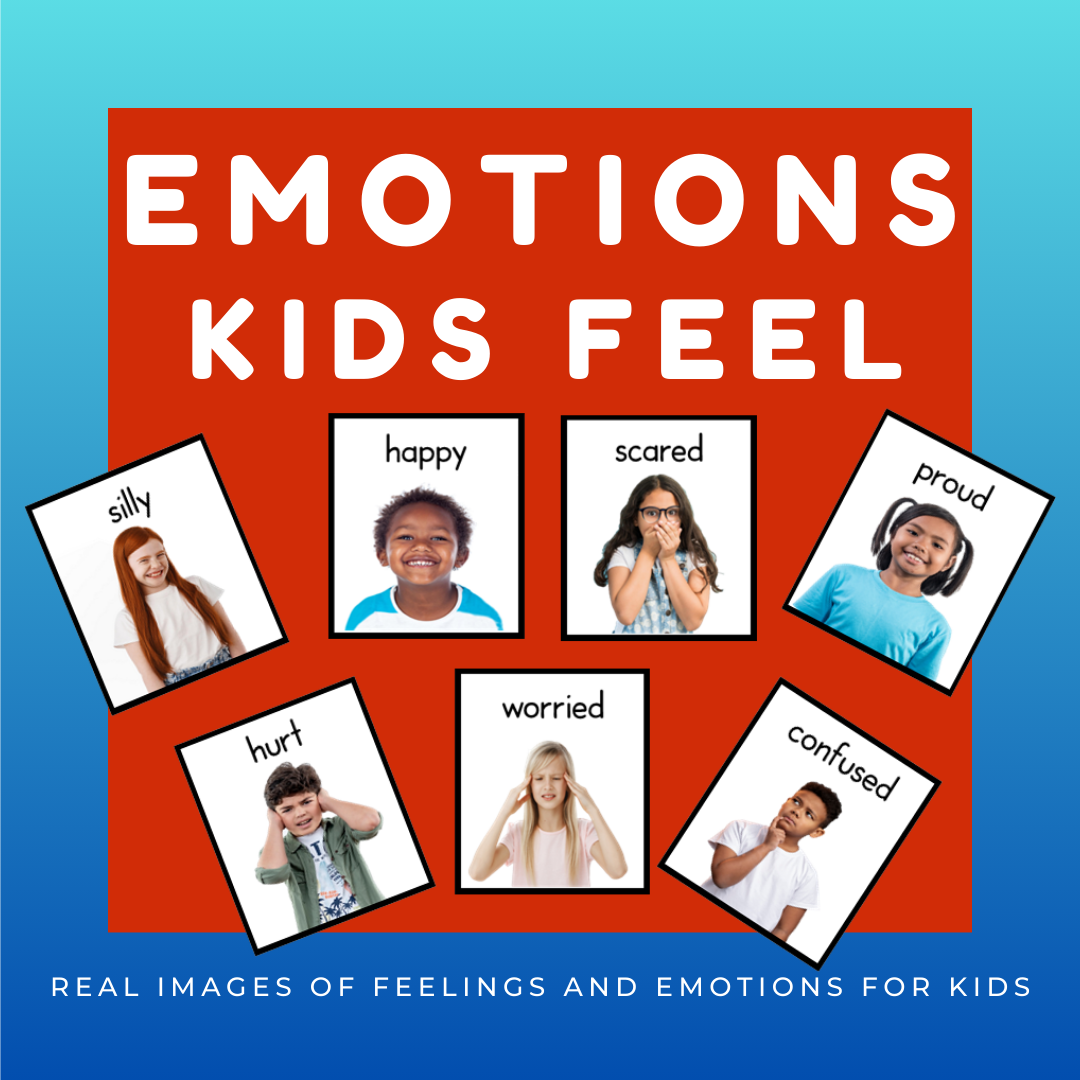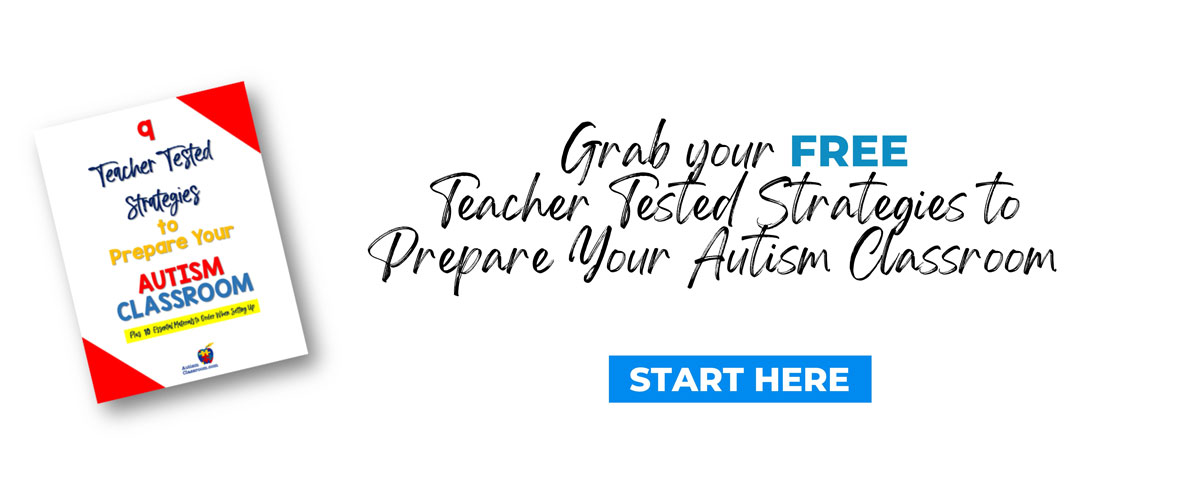Social Skills for Autism
Inside: What social skills ideas are best for encouraging social skills in autism classrooms and in the home, as well as books, worksheets on social skills, workbooks and examples of social skills activities.
This page includes affiliate links. Learn more here.
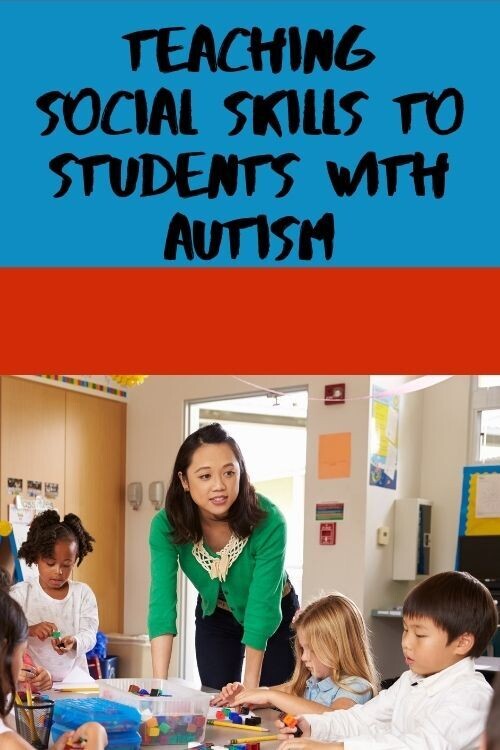
Social Skills are an area where many individuals with autism may need some direct instruction and guidance. Teachers and caregivers often struggle with what social skills activities to teach, how to teach social skills, and in what order. While there is no set standard way to teach social skills, it may be helpful to focus on a few areas first when getting started. (You may want to bookmark this page and come back often.) First, think about lessons that teach the individual self-management to help them recognize their own behaviors. Second, when thinking about what social skills to teach in the classroom, teach your students to identify emotions in themselves and in others. Next, promote self-awareness so that students understand how they interact with the world around them. Last, encourage communication through pictures, gestures, writing or words. Resources like these Social Skills Printables or Teen's Edition-Social Skills Printables can get you started with figuring out what social skills to begin teaching. Additionally, there are many other strategies available to teach social skills in autism support classes and in related environments:
- Provide Frequent Opportunities for the Students to Practice
- Try Video Modeling
- Develop and Read Social Sentences and Picture Cues
- Self-Management Support
- Identify Emotions
- Give the Individual Choices More Frequently
- Make Social Scripts
- Using Board Games to Teach Social Skills
- Incorporate Power Cards
- Use Role Playing
- Design Social Stories for the Student
- Direct Instruction of Social Skills
- Implement/Follow a Social Skills Curriculum
- Social Skills Printable Lessons, Behavior Skills Printable Lessons, Play Skills Printable Lessons
- Links, Goals, Videos and Tips
When working in a classroom, on the playground or at home with autistic children, you might need to utilize various social skills activities for this area of development. Let’s take a closer look at some examples of social skills with autism related strategies and supports.
Practice During Play
Children with autism need extra time to develop their play skills such as learning to take turns or sharing with others. You can encourage this behavior by continuously practicing these types of games over and over again. Passing a ball or playing cards is a typical game where you can reinforce the rules with verbal clues and picture cues by saying “my turn” and “your turn.” Use picture cards for students with limited speech so that they can also communicate with you. They’ll be able to cope better with winning, losing, and taking turns when you utilize this in your social skills curriculum. Try using dolls or props to practice daily activities--you could eat dinner, visit the supermarket, or have a tea party to teach expected behaviors in specific situations.
Video Modeling
It has been especially challenging for special education teachers to develop the necessary social skills during this pandemic because they find it difficult to connect with their students virtually. If you’re struggling with your online classes, take advantage of video modeling! Even if you are in-person and need social skills for autism support classrooms , this works too! You can analyze videos of social behaviors with your students by pausing them to discuss expressions, body language, tone, and additional social cues. You can either record your videos or use clips from shows and movies. You have access to thousands of scenes for different social situations, so this method is very advantageous for improving social skills for autism. Use it to explain society’s rules and comprehend people’s feelings. This site by Indiana University-Bloomington gives some things to think about when using video modeling.
Picture Cues and Social Sentences
The social skills of autism of course, differ with each individual student on the autism spectrum. Visualization is essential for many children with autism to learn social skills. Try using various picture cards, words, and checklists to help your students remember which behavior is expected of them for each location. You can have them organize the pictures in the order of events that would occur, such as ordering ice cream. They would place the greeting card first, then place their order, hand over the payment, receive the dessert, etc.
Self-Management Support
Understanding how to manage your behavior is one of the essential social skills for kids to learn early on. These social rules can be difficult for a child with autism to know, but developing a self-management system can drastically affect their social independence and overall success in daily life. The most common type of self-managing system is with a paper and pencil, where the student marks an X or O to indicate whether they completed a task. If students have difficult with writing, use a laminated paper with checkmarks that they can Velcro™ on and off.
Identify Emotions
Not only do children with autism struggle to identify emotions expressed by their peers, but they also struggle to understand their own emotions as well. Teaching the names of the emotions and the facial cues associated with the emotions can help. Here is a free set of emotions flashcards that can be downloaded and used for this purpose. Practice looking at expressions in pictures and identifying emotions in picture books, and also, teaching coping skills like anger management, and trying to debrief after an overwhelming emotional event.
These other different set of cards (below) are another favorite that I like to order for teams when I am consulting. They help make it easy to show different faces and emotions.
Allow for Frequent Individual Choice Making
Individual choice making is a natural part of everyday life and shouldn’t be withheld from individuals with autism. It is your job as a parent or teacher to provide opportunities for your child to make choices throughout their day. Something as simple as choosing between working on their math or reading homework can help develop independence and proper communication. For students with limited speech, have them point to their choice or give a picture card, if needed.
Make Social Scripts
Social scripts allow you to change or teach a particular behavior in a story format that is easy to make, individualize and use daily. Every script needs to include a description of the problem, a basic and easy-to-understand behavioral expectation, and a brief script written from the child’s perspective. Using these “stories” provides a structure to kids with autism so that they can deal with situations that might otherwise be stressful, such as working with classmates, dealing with a change, or riding a noisy bus. When teaching social skills with autism support classrooms, you might want to incorporate some active practice along with the scripts.
Using Board Games to Teach Social Skills
Board games are excellent for developing social skills since they incorporate both learning opportunities and a fun source of entertainment. Children will learn how to take turns, understand rules and their importance, and learn appropriate behavior for winning and losing. Jenga, Connect Four, or Chutes and Ladders are great choices to start with since they are relatively simple and easy to play independently. If you need to modify the game at bit, you can. For example, Connect Four can change to a turn taking game if you put in one checker, the child puts in one checker, then you go again, without the expectation of 4 in a row.
Incorporate Power Cards
Power Card is a social skill strategy created by Elisa Gagnon in the early 2000s which utilizes your child’s favorite celebrity or character to teach behavioral expectations and consequences. For example, if your child has a particular interest in Iron Man, you can use pictures of Iron Man to reinforce a social script and demonstrate the target behavior. And…because Iron Man says it then it has to be right!!!
Role-Playing
Role-playing is a fantastic tool for you and your student to practice how they can play with their peers and friends. You could act out a conversation they might have or play a game before the playdate. It is also helpful for practicing verbal skills by recreating scenes that they recently watched on television shows. Role-playing is excellent for problem-solving, too. You could work through various social problems with your older students, such as a broken toy or fight over computer time, and create solutions together. Social skills for kids who have limted verbal skills could incorporate visual pictures and instructions on how to use the icons to communicate.
Design Social Stories for the Student
This low-cost therapy strategy can help improve autistic children’s understanding of social concepts and improve their responses and behaviors. Using these stories, you can teach the child how to behave in various social situations, from being at the doctor’s office to play with other kids at a park by detailing the setting, events, and appropriate behaviors. Take a look at how Carol Gray explains how to specifically design these stories for maximum benefit. Bonus golden nugget!!!!-- We've curated a list of great places to find social stories.
Direct Instruction of Social Skills Activities
This type of strategy first has you identify which social skills need to be learned, establish the steps to achieve them, and then practice them together with the student in various environments and settings. When thinking about social skills for autism worksheets, direct lessons and creativity can help. Direct instruction can occur with labeling emotions, social skills worksheets, games or roleplaying, or literal teaching of imitation skills, play skills, social skills and behavior skills. See our article on using social skills worksheets in the classroom for more details on how to accomplish this.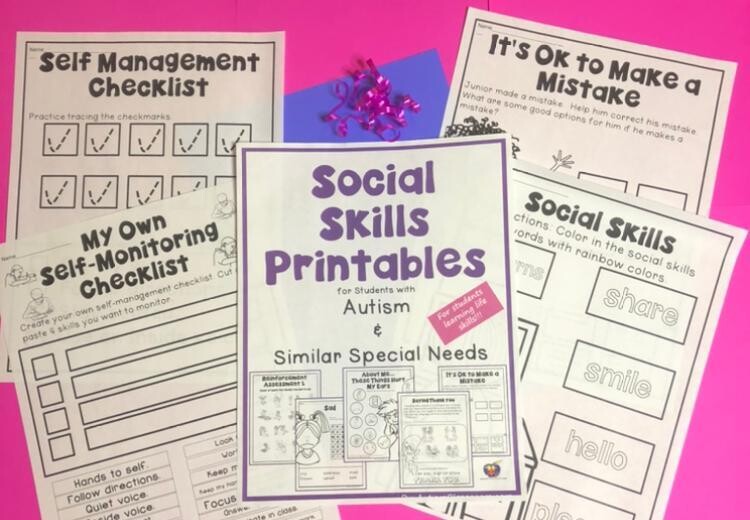
Implement/Follow a Social Skills Curriculum
There are dozens of excellent social skills curriculum resources available to you to use and implement in your classroom or home. To begin teaching social skills, you could conduct standardized and informal assessments to identify the exact skills that need work and then introduce that skill through various methods listed above like social stories, video modeling, roleplaying, and rules. Begin working regularly on the skills to support the child in creating positive social interactions.
Utilize these different strategies in this social skills list to teach your students and improve their skills in a structured and interactive manner. The Social Skills Printables have been popular with many teachers and parents. You’ll help them learn what social skills you want them to learn, and it will be much faster when you implement various methods and techniques that are tailored to their needs. Once the skills are learned, be sure that you practice these same social skills activities in different environments to promote generalization.
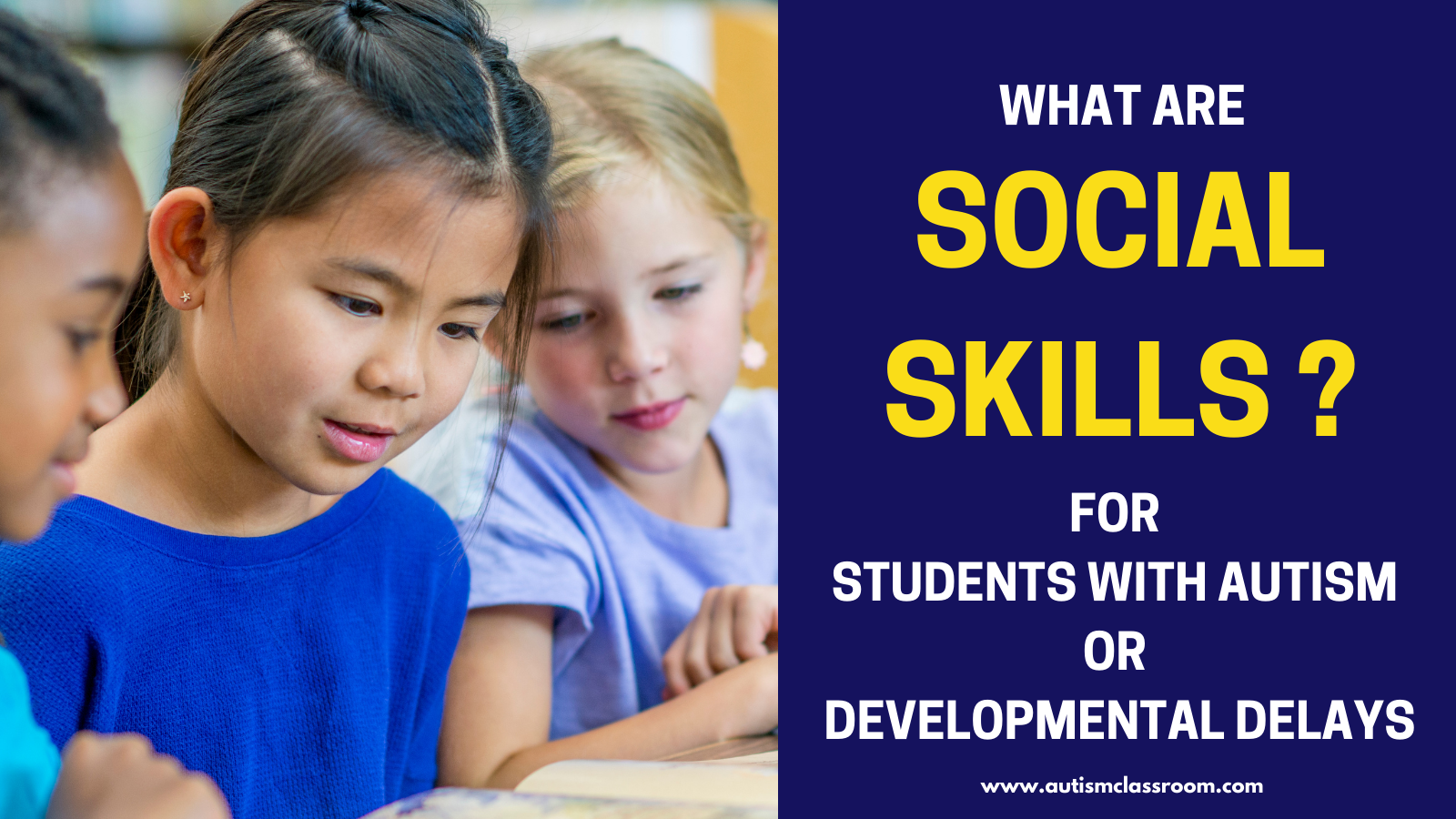
More Articles from Us About Social Skills for Autism Classrooms
Learn techniques by reading the 5 Strategies to Teach Social Skills for Autism Support Classes. Or explore Social Skills Training for Students with Autism to find out ways you can increase and encourage social interaction. Our Why Social Skills Are Important article shares thought on the rationale for teaching social skills. While Summer Social Skills Activities for Kids with Autism When Summer Camp is Not an Option and Building Communication Skills help families to begin to build social interaction skills at home. Additionally, the instruction of behavior skills and play skills is equally important in this journey.
Social Skills Ideas and Links
Check out this site for evidence based ideas and activities.
Find information about teaching social skills activities to students with autism to increase peer interactions here.
Social Emotional Learning for students is more important than ever. This site gives 15 activities to foster SEL.
What are the building blocks of social skills development? Check this site to find out.
Using Social Skills Videos for Kids
A blog with ideas for great ways to use videos and animated clips with students.
How to utilize Youtube to help with your social interaction lessons here.
Videos by students for students to learn about ways to interact socially.
How To Incorporate Social Skills In The Classroom or Home (Videos)
AutismClassroom.com's Video for Teachers and Parents about Building Social Skills in Students with Autism. This can be used as a quick tutorial or introduction to a presentation about building social interactions in students. Or can be shared with staff members in an email to provide some professional development.
This video provides tips for families and school teams.
A short video about what social skills to teach in this area can be found when clicking the image below.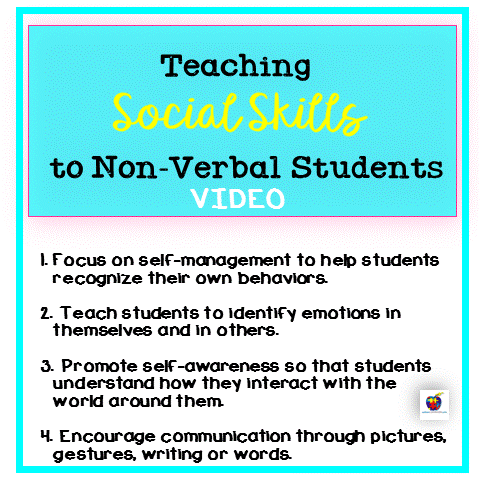
What are Social Stories and How to Use Them (Links)
This guide from the creator of social stories is a comprehensive resource on how to introduce social stories.
This explains how children benefit from the process of social stories.
This is our fantastic resource blog article about 15 + social story resources.
Social stories can help prepare children for specific events or tasks.
Here are some social stories about friendship that provide a way to teach friendship and social skills.
Incorporating visuals, like photographs, drawings, etc., into a social story can help aid in understanding.
ABA Educational Resources has an entire library of social stories. These social stories for children with autism cover topics ranging from playing with friends, going to the movies, walking the halls, and eating at the table.
These apps can help you create your own social story.
Respecting personal space is a social norm that children sometimes struggle with. Use social stories on personal space as a visual tool to explain or suggest appropriate behavior.
This site provides a list of the dos and don’ts when making social stories for children with autism.
If you want to learn how to effectively incorporate social stories into your classroom, this school teacher provides tips on writing the stories.
Are you dealing with a biter? This social story narrative on biting can try to help bring a stop to it.
Social stories on following directions can help teach children how to follow instructions.
This teacher uses social stories potty training techniques to help children with toilet training.
If you are needing to use social stories sharing may be a topic that needs to be addressed. Ready-made social stories on the topic of sharing are available here.
Tips for Increasing Social Skills for Kids
Tips- Here are tips on developing critical social skills for kids and why it’s so important.
Ideas for Goals- Measurable goals are a critical component of a child’s IEP. This site provides a list of over 100 social-emotional goals.
Books- Reading books is an effective method for teaching social-emotional skills. Here are ten recommendations for books that touch on a variety of topics.
Worksheets and Workbooks- We have a large variety of workbooks made specifically for students with special needs and our best selling printables break social skills down into 4 sections. (See below.)
Ways to Practice- This site provides some practical ways to practice social skills with your child.
Ask for Help from Peers - A peer mentor can encourage behavior modeling while providing a child with a hands-on approach to navigating social skills for autism support and also get an opportunity to form connections.
Links for Emotions, Self-Regulation and Self-Management
Children with autism may sometimes seem unresponsive on the surface, but that doesn’t mean they aren’t experiencing emotions; they might just not understand them. These therapy techniques can help teach feelings and how to express emotions.
This site shares some great tips for using visualization to teach children how to recognize different emotions in another person and read body language.
Incorporating playtime and fun as part of your teaching method can help children feel safe learning about emotions.
Using everyday interactions can help an autistic child learn about emotions organically. This site lists several examples of incorporating emotions this into your natural conversations.
Here’s a list of fun activities for students with special needs to teach social skills, practice empathy, and recognize social cues.
Helping children identify things that could help relax them or regulate their feelings is essential for their emotional education.
In this link, Dr. Stephen M. Edelson breaks down the process of self-management into three components: Self-Monitoring, Self-Evaluation, and Self-Reinforcement. Each plays a key role in a child’s ability to develop as an independent person.
To foster self-regulation, Occupational Therapists develop strategies to support children in areas where their diagnosis can interfere with their daily living by using what they already have at home.
Debriefing after an emotional event is a critical part of helping children with autism understand why they felt that way and is an opportunity to discuss strategies that could be helpful the next time they experience it.
Children with high-functioning autism also experience emotional frustration; help them by identifying their coping mechanisms.
This eBook provides instruction on teaching social skills and emotion management.
Social Skills and Social Behavior are areas covered in our workbooks on this topic here.
How Social Skills Develop
Social skills development is essential for anyone who wishes to communicate effectively and interact appropriately with those around them. From the moment a child is born, they are learning social skills. Most people learn social skills through observation and play. Babies mimic the smiles and facial expressions of the adults around them. Toddlers and young children gain social skills through play as they imitate the roles and actions of others. However, social skills for autism often develop in children through more support and explicit instruction.
Goals for Social Skills
When working with students with autism, their goals for social skills should be based on their age and current abilities. Once you have observed and assessed the student’s needs, you may want to work with the family and learning team to set appropriate goals for social skills. Goals might include skills such as:
- smiling and using appropriate greetings when they enter the classroom,
- taking turns and sharing materials,
- learning to work in a group,
- or looking in the direction of the person they are communicating to.
Start with smaller, manageable goals for social skills, and then build on those goals as students experience success.
Develop Interventions for Social Skills
Once social skills goals have been established, there are different interventions for social skills that can be used to help students make progress towards those goals. The first step is to talk to the adults who will be supporting the intervention and explain the importance of that social skill. Once they what to work on, teachers, specialists and para-educators can model the skill to the student and use supports and interventions for social skills. For example, interventions such as social stories could help the student gain familiarity with a specific social expectation. You can also use checklists or worksheets to help guide students as they practice their new skills. For example, when learning how to play games with their peers, students can be given a checklist with steps such as: follow the rules, remember to take turns, use kind words, and smile whether you win or lose. These checklists can also include visual images or picutres to help students remember each step.
Social Skills and Communication
The more that students with autism develop their social skills, the better they will be able to communicate with those around them. Social skills and communication go hand in hand and help students to listen to others, understand their peers’ verbal and nonverbal communication, and participate in daily social activities. When teachers take the time to work on social skills and communication with students with autism, they are providing them with the tools that they will need to build friendships, understand others, and ensure that they are understood by those around them. While students with autism may struggle with social skills, the right support can prepare them to interact with others and be effective and confident communicators in their classrooms.
Books About Teaching Social Skills
The New Social Story Book has over 150 stories.
The Social Skills Picture Book shows pictures of social situations.
Social Skills Workbook for Young Students is our contribution to the effort of teaching social skills.
Social Skills and Adaptive Behavior in Learners with Autism Spectrum Disorder looks at current research in the field.
Picture Books for Students
My Day Is Ruined is a book about dealing with situations when plans change.
A Little Spot of Flexible Thinking helps kids to learn to deal with changes in routines.
Emotions Kids Feel helps kids see faces of real emotions. Click on the book below to see more.
Other Resources from Autism Classroom
Printables
Social Skills Bundle
Social Skills Printables
Social Skills Interactive Notebook
Behavior Skills Printables
Play Skills Printables
Language Skills Printables
Workbooks
Social Skills Workbook
Language Skills Workbook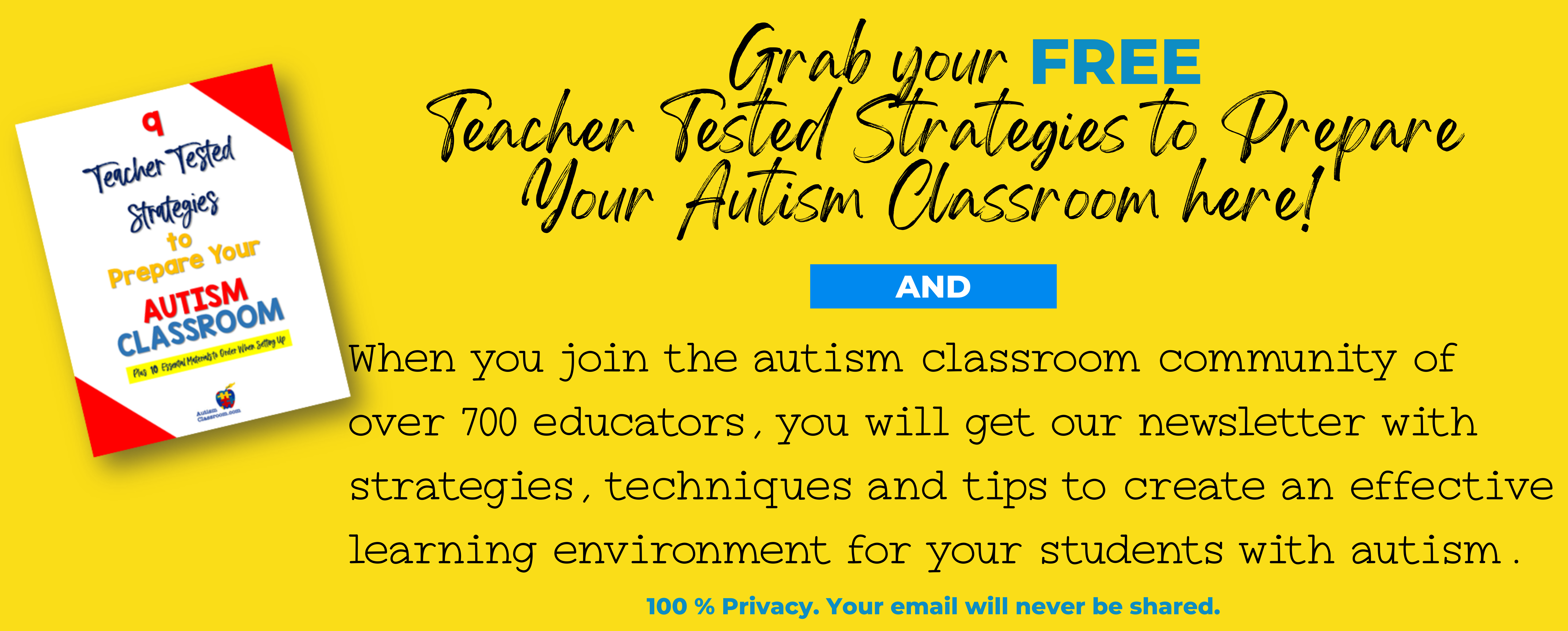
Share this article with a friend or family member. Click the plus sign to share a pin below: